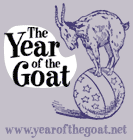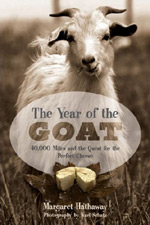Though I'd seen demonstrations of spinning before, I'd never really considered how time consuming it must have been, before the industrial age and the advent of textile mills, to make such simple things as socks or sheets. Not only would a person have needed to keep and shear a flock of sheep or goats, but they would also have had to wash, pick, card and spin the fibers before even thinking of knitting or weaving a piece of cloth. It's amazing to me that people didn't wander around naked until the nineteenth century. Even at Friends' Folly, it's not a speedy process, so I can't imagine how long and tedious it would be by hand. Perhaps, though, there's the same therapeutic value in the repetition that Paul Hopkins finds in milking. When the machinery was turned off, there was something almost primally calming about being surrounded by piles of fleece. — MMH
June 2004 March 2004 February 2004 January 2004 |
|
Join Our Mailing List!
send an email to: info@yearofthegoat.net |
|
|
|
COMING SOON:
- Recipes - Event Schedule - More Farm Updates |
|
|
 |
| Pogo stands with Dory, one of the angora does on Friends' Folly Farm | more photos |
Happily for the fiber farmers of Maine, there is Friends' Folly Farm. Owned by Pogo (just one name, she said, like Madonna or Cher) and her partner Marsha, Friends' Folly has both its own herd of angora goats, and in a small building to the side of the house, a cottage-industry sized carding and spinning machinery. Because the machines are small, they can be run with a fraction of the fiber needed to operate commercial mills. This allows Pogo, Marsha and their customers to keep the fibers from certain animals distinct, and even to design their own blends.
This site is powered by Movable Type
Web site design by Karl Schatz
|
Our Book is Here!
The Year of the Goat: 40,000 Miles and the Quest for the Perfect Cheese
BUY THE BOOK: |
|
YotG on Public Radio!
In 2004 we made 4 appearances on the now sadly off the air, but then nationally syndicated PRI show, The Next Big Thing |
|
|
|
Miles Traveled: 41409
Next Stop: A farm of our own |
|
|

